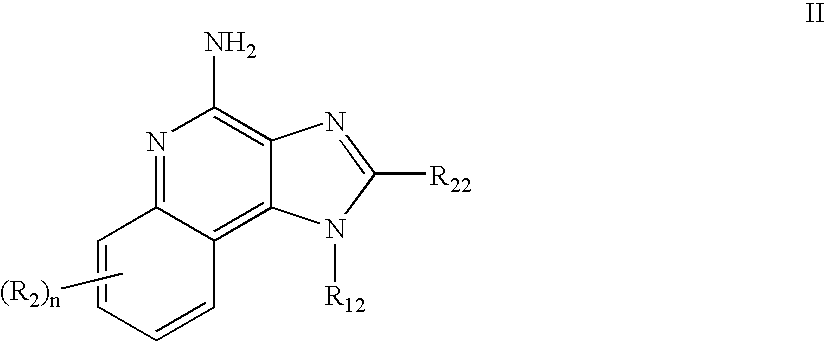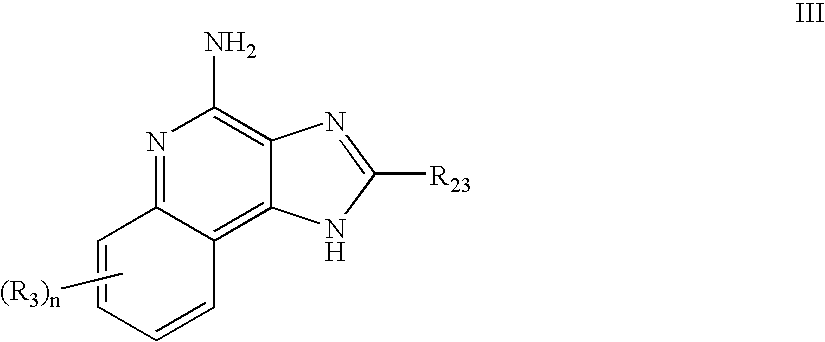Immune response modifier formulations and methods
a technology of immune response and formulation, applied in the field of immune response modifier formulations and methods, can solve the problems of inability to provide therapeutic benefit via topical application of an immune response modifier for treatment of a particular condition at a particular location, physical instability of the formulation, degradation of excipients,
- Summary
- Abstract
- Description
- Claims
- Application Information
AI Technical Summary
Benefits of technology
Problems solved by technology
Method used
Image
Examples
examples
[1626] The following Examples are provided to further describe various IRM formulations and methods according to the invention. The examples, however, are not intended to limit the formulations and methods within the spirit and scope of the invention.
Test Methods
Test Method 1—IRM 1 Compound Content and Sorbic Acid Content
[1627] A gradient reversed phase high performance liquid chromatography (HPLC) method was used to determine the amount of 2-methyl-1-(2-methylpropyl)-1H-imidazo[4,5-c][1,5]naphthyridin-4-amine (IRM Compound 1) and sorbic acid in cream formulations.
[1628] HPLC parameters: Analytical column: ZORBAX RX-C8, 5.0 micron particle, 150×4.6 mm (available from Agilent Technologies, Wilmington, Del., USA); Column temperature: 30° C.; Detector: UV at 254 nm; Flow Rate: 1.0 mL / min; Injection volume: 25 μL; Mobile phase A: 62% aqueous (0.2% sodium 1-octanesulfonate, 0.2% triethylamine, 0.2% of 85% phosphoric acid), 21% acetonitrile, 17% methanol; Mobile Phase B: 20% aqueous (...
examples 1-6
[1648] Table 1 summarizes topical formulations made in accordance with the present invention in a percentage weight-by-weight basis. The formulations were packaged in aluminum tubes with an epoxy phenolic lacquer liner.
TABLE 1IngredientEx 1Ex 2Ex 3Ex 4Ex 5Ex 6IRM 10.010.030.100.300.601.00Isostearic acid5.005.005.007.0010.0010.00*Medium-chain4.004.004.004.004.004.00TriglyceridesCARBOPOL 9801.001.001.001.001.001.00POLOXAMER 1883.503.503.503.503.503.50Propylene gylcol5.005.005.005.005.005.00Methylparaben0.200.200.200.200.200.20Sorbic acid0.150.150.150.150.150.15BHA0.100.100.100.100.100.10Edetate disodium0.050.050.050.050.050.05dihydrateSodium hydroxide0.800.800.800.800.800.80Solution 20% w / wPurified water80.1980.1780.1077.9074.6074.20
*Caprylic / capric triglyceride available under the trade names CRODAMOL GTCC-PN (Croda, Inc) and MIGLYOL 812N (Sasol).
[1649] The creams of Examples 1-6 were stored at 40° C. at 75% relative humidity. At selected time points samples were analyzed for IRM ...
examples 7 & 8
[1650] Table 3 summarizes topical formulations made in accordance with the present invention in a percentage weight-by-weight basis and a formulation prepared without an antioxidant (C1). The formulations were packaged in glass containers.
TABLE 3IngredientEx 7Ex 8Ex C1IRM 10.300.300.30Isostearic acid7.007.007.00*Medium-chain Triglycerides8.008.008.00CARBOPOL 9801.001.001.00POLOXAMER 1882.502.502.50Propylene gylcol5.005.005.00Methylparaben0.200.200.20Sorbic acid0.150.150.15BHA0.10——BHT—0.10—Edetate disodium dihydrate0.050.050.05Sodium hydroxide Solution 20% w / w0.800.800.80Purified water74.9074.9075.00
*Caprylic / capric triglyceride available under the trade names CRODAMOL GTCC-PN (Croda, Inc) and MIGLYOL 812N (Sasol).
[1651] The creams of Examples 7, 8, and C1 were stored at 40° C. at 75% relative humidity and at 55° C. at ambient humidity. At selected time points samples were analyzed using Test Method 1 described above for IRM 1 and sorbic acid content. The results are shown in Tab...
PUM
| Property | Measurement | Unit |
|---|---|---|
| Percent by mass | aaaaa | aaaaa |
| Percent by mass | aaaaa | aaaaa |
| Percent by mass | aaaaa | aaaaa |
Abstract
Description
Claims
Application Information
 Login to View More
Login to View More - R&D
- Intellectual Property
- Life Sciences
- Materials
- Tech Scout
- Unparalleled Data Quality
- Higher Quality Content
- 60% Fewer Hallucinations
Browse by: Latest US Patents, China's latest patents, Technical Efficacy Thesaurus, Application Domain, Technology Topic, Popular Technical Reports.
© 2025 PatSnap. All rights reserved.Legal|Privacy policy|Modern Slavery Act Transparency Statement|Sitemap|About US| Contact US: help@patsnap.com



